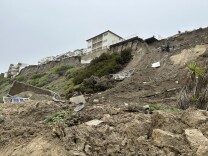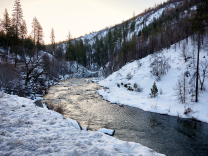
Next Up:
0:00
0:00
-
Listen Listen
Climate & Environment
Some of the country's highest home insurance prices are in the central U.S., a region generally considered to be protected from climate-driven disasters.
Listen
4:32
Sponsor
More Stories
-
There's no formal or regular process to monitor slide-prone coastal bluffs.
-
The multi-family homes were red tagged by authorities late Wednesday.
-
The second of two hearings takes place on Wednesday, March 15.
-
With the storm expected to park itself over L.A., dangerous debris flows and flooding are still a concern across SoCal.
-
Like for hurricanes, there's a scale for atmospheric rivers. But it may be a while before it's the norm.
-
Our soil is so saturated this year that debris flows are a concern across SoCal.
-
UCLA plans on developing paint that actually helps keep buildings cooler.
-
After heavy snowfall left cows in northern California stranded and starving, officials launched an unusual rescue mission.
-
One in five Sierra Nevada conifers are no longer compatible with the environmental conditions around them, raising questions about how to manage the land. Researchers say it may get worse.
-
Starting at 8 a.m. Tuesday resident living in burn scar areas of the Alisal and Cave fires must leave the area. Another atmospheric river is expected to bring heavy rainfall and dangerous conditions.
-
A new atmospheric river set to arrive as soon as Monday could worsen already severe flooding, as the extra rain and snowmelt threaten to overflow rivers and streams at lower elevations.
-
As storms melt snowpack, managers released water to prevent reservoirs from overflowing and flooding Central Valley towns — and that sends water into the ocean. The warm rains melt snow that ideally would last into spring and help with water deliveries.
Researchers found that in drier years, larger animals are more likely to head closer and closer to where people live.
Listen
4:05
Support your source for local news!
In case you missed it
-
911 recordings obtained by LAist shed light on why and how emergency planning continues to leave people with disabilities behind.
-
LAist investigates illicit dumping at three Antelope Valley sites.
-
An LAist investigation found toxic heavy metals in samples of fire retardant collected from the Palisades, Eaton and Franklin fires. Here's what that means.
More Stories
-
California’s electric rates are among the highest in the country. Three big power companies propose charging fixed rates based on income, saying low-income customers will save money. Critics doubt it’ll work.
-
An excessive heat warning is out for the Antelope Valley starting today.
-
The National Oceanic and Atmospheric Administration has proposed "critical habitat" designations in Southern California.
-
The National Weather Service forecasts significant heat for the weekend.
-
Outdoor workers have legal protection in extreme heat, but that's not the case for indoor workers, who can be just as susceptible to heat illness and even death. Enforcing the rules remains an issue.
-
Clear skies, sunshine, and a couple of excessive heat warnings for the deserts remain until Saturday.
-
The largest single-employer strike in U.S. history could frame worker power as a climate solution.
-
Utility-scale solar farms spreading rapidly across the desert Southwest are stressing the region’s already overtaxed groundwater and communities are beginning to push back.
-
Saturday was record breaking. Sunday's going to more of the same, with temperatures cooling around Tuesday.
-
As nights warm and droughts intensify, past models predicting fire behavior have become unreliable. So California is working with analysts and tapping into new technology to figure out how to attack wildfires. Gleaned from military satellites, drones and infrared mapping, the information is spat out in real-time and triaged by a fire behavior analyst.




































